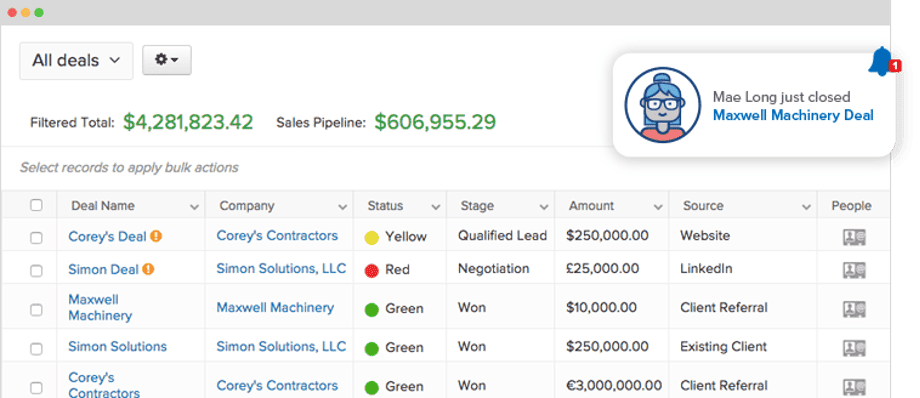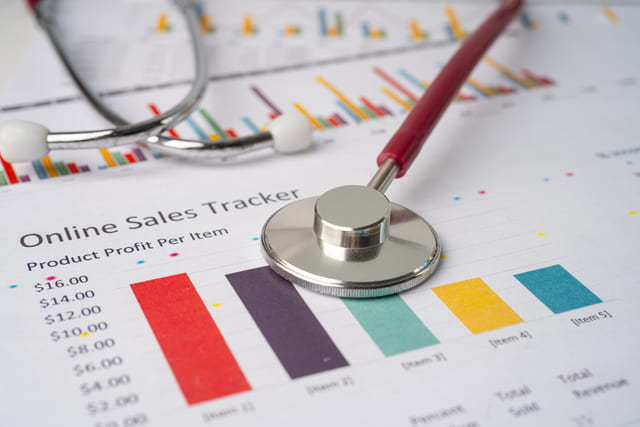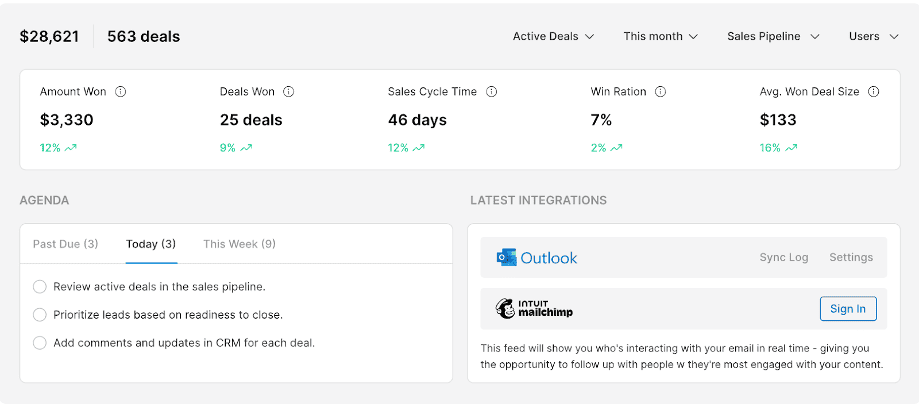Did you know that 44% of executives say their company’s sales pipeline is ineffective? An inefficient pipeline can lead to stalled deals, wasted resources, and missed revenue opportunities.
As a sales leader, your priority should be eliminating inefficiencies and maximizing revenue potential. Regular diagnostic checks and agile fixes are essential to maintaining a healthy pipeline and ensuring smooth lead progression.
This comprehensive guide will help you evaluate and optimize your sales pipeline for sustained growth, efficiency, and long-term success.
Identifying and Overcoming Sales Pipeline Inefficiencies
Before optimizing your sales pipeline, it’s essential to understand the typical pitfalls and blockers that make pipelines inefficient.
1. Ineffective Lead Qualification
Sometimes, background checks and initial verification of leads can result in unqualified leads. These leads get stuck in the sales funnel longer than necessary, wasting valuable resources and time. This situation also hinders all types of leads, particularly high-potential ones, from progressing efficiently, leading to unexpected bottlenecks.
| Tip: Implement sales pipeline management software that automates lead scoring, ensuring only high-quality leads move forward. |
2. Prolonged Sales Cycles
Prospects can get stuck at any stage throughout their process, which delays deal closing. Long sales cycles usually indicate issues in the negotiation process or follow-up inefficiencies.
You can read this article to discover how to build a sales pipeline and shorten sales cycles effectively.
3. Overwhelmed Sales Teams
When team members juggle multiple tasks to manage too many leads, they are likely to feel tired and stressed. This often results in improper follow-ups or lead tracking, creating bottlenecks. Additionally, mistakes may happen when resources are stretched too thin across various sales pipelines.
| Tip: Use sales CRM software to centralize lead tracking, automate follow-ups, and balance workloads effectively. |
4. Disjointed Team Communication
Different teams participate at different stages of a lead’s sales journey. It is essential for these teams to maintain a single line of communication and have a unified understanding of all discussions with clients. When internal communication breaks down, it slows down conversions and creates bottlenecks in the process.
5. Inconsistent Lead Scoring
A well-defined Ideal Client Profile (ICP) ensures accurate lead scoring based on key factors such as budget, client type, and business size. Misalignment in ICP creation can lead to incorrect scoring, misclassified leads, and missed opportunities.
| Ideal Client Profile: An ICP provides a factual description of your target audience, detailing demographics, buying behaviors, and customer service interactions. |
Now that we’ve identified common sales pipeline inefficiencies let’s explore how to transform your pipeline for success.
7-Step Guide to Promoting Pipeline Success
To ensure your sales pipeline operates at peak efficiency, you must monitor key factors, conduct regular assessments, and implement strategic improvements. Let’s explore the essential elements of a successful pipeline and how to optimize it for growth.
1. Know What a Healthy Sales Pipeline Looks Like

A poorly maintained pipeline can lead to blocked opportunities, stalled sales cycles, and unpredictable revenue. However, these issues can be mitigated by consistently refreshing your pipeline with new leads and segmenting them effectively.
A healthy pipeline should:
- Maintain a steady flow of high-quality leads.
- Distribute leads evenly across early, middle, and late funnel stages.
- Provide accurate revenue forecasts to guide decision-making.
Accurate revenue forecasts serve as the foundation for sustained growth, helping to allocate resources, set goals and realistic targets, and make informed decisions regarding hiring, marketing, and other operational matters.
| Tip: with a CRM for sales, you will have instant visibility to these and other key metrics to ensure the optimized health of your sales pipeline. |
2. Optimize Lead Qualification and Scoring
To improve efficiency, it’s crucial to clean and prioritize leads effectively. Ensure you:
- Define clear criteria for high-quality leads and eliminate unqualified ones early.
- Develop an Ideal Customer Profile (ICP) to categorize and score leads accurately.
- Implement a lead scoring system within your CRM to focus on high-potential prospects.
- Automate lead qualification to minimize manual efforts and allow your team to focus on nurturing leads.
3. Track Important Pipeline Metrics and Indicators
Tracking pipeline metrics can be challenging, as constant monitoring requires a lot of time, effort, and resources. Additionally, there are so many cogs that work together that it can be hard to track every single one.
A healthy sales pipeline is the backbone of a successful team, ensuring that your pipeline setup has fewer stagnant leads and bottlenecks. A sales pipeline audit should assess:
- Conversion rate: identify where prospects drop off and optimize those stages.
- Lead velocity: detect stagnation and intervene before leads go cold.
- Lead quality: prioritize high-potential leads that align with your ICP.
- Data-driven decision-making: use key metrics like win rates and sales cycle length to refine strategies.
4. Identify and Address Bottlenecks
Once you understand what a healthy sales pipeline looks like and actively track indicators and metrics, you will better understand your blockers. Here is how you can address some common bottlenecks:
- Slow sales cycles: flag this bottleneck in real time using process maps to identify causes of prolonged cycles.
- Sales reps management: overwhelmed team members can’t work at full capacity. A CRM with AI-assisted answers enhances client retention and service speed.
- Inefficient lead qualification: targeting the wrong prospects creates bottlenecks. Define an ICP and implement a lead scoring system to improve this.
- Knowledge gap: sales teams waste time searching for information. A centralized knowledge management system provides instant access to collective knowledge.
5. Maintain Open Lines of Communication
A seamless sales process depends on collaboration across teams. A CRM for sales should:
- Integrate client data to ensure smooth lead transfers.
- Automate lead handoffs to client success teams for seamless onboarding.
- Reduce churn by enhancing post-sale follow-ups and upselling opportunities.
6. Leverage CRM and Automation for Efficiency
Using a sales CRM with automation and AI tools can significantly improve sales pipeline management by reducing manual workload and increasing efficiency.
- Automate lead qualification: CRM software can score, and segment leads, ensuring only high-quality prospects reach the sales team.
- AI-powered email assistants: sales teams are uniquely positioned to leverage AI capabilities via email assistants and smart conversational bots.
- Automate repetitive tasks: tasks such as follow-up reminders and data entry can be automated, allowing sales teams to focus on core sales activities.
75% of professionals already use AI at work. By integrating AI into your sales pipeline management, your team can work smarter, reduce inefficiencies, and focus on revenue-driving activities
7. Enhance Data-Driven Decision Making with Reporting and Integrations
A well-integrated CRM system provides real-time reporting and seamless third-party app integrations, enabling sales teams to work more effectively.
- Custom reporting: generate real-time reports that monitor pipeline health and key sales metrics to drive strategic decision-making.
- Integrated third-party applications: connecting emails, calendars, and document-sharing tools within your CRM reduces admin work and boosts efficiency.
- Predictive analytics: use AI-driven insights to refine sales tactics, improve forecasting, and optimize resource allocation.
By incorporating these strategies and leveraging automation, you can build a high-performing sales pipeline that drives sustained growth and efficiency.
Continuous Sales Pipeline Optimization, Review, and Refinement
A successful sales pipeline management strategy requires ongoing optimization. By performing regular sales pipeline audits, sales teams can identify inefficiencies, refine lead qualification processes, and leverage automation to enhance workflow efficiency.
A sales CRM automates time-consuming tasks like follow-ups and client data entry and improves visibility across multiple sales pipelines. This lets you focus on high-value activities such as engaging leads, closing deals, and building long-term customer relationships.
By continuously optimizing your sales process, you can eliminate bottlenecks, improve conversion rates, and ensure your pipeline remains a powerful engine for business success.
Ready to optimize your sales pipeline? Check out Pipeline CRM’s flexible pricing plans to find the best fit for your team!





